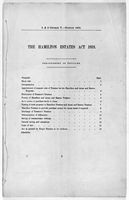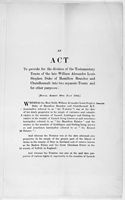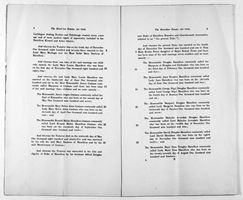 |
||||||||
| The Hamilton Estates Act 1918 | ||||||||
|
© Lennoxlove House Ltd
|
||||||||
| This private Act
of Parliament, which received the Royal Assent on 30 July 1918, is
entitled 'An Act to provide for the division of the Testamentary Trusts
of the late William Alexander Louis Stephen Duke of Hamilton Brandon
and Ch‚telherault into two separate Trusts and for other purposes'.
In its preamble it narrates that at the time of his death the 12th
Duke owned what are briefly described as the Hamilton Estates
and the Kinneil Estates (on mainland Scotland), the Arran Estate (the
greater part of the Island of Arran), and the Easton Estate and Great
Glemham Estate both in Suffolk, and it repeats at length the complex
provisions of the 12th Duke's Will as to the administration of his
estate.
It tells that the debts over the late duke's estates had been paid off by 1 July 1908, since when the 13th Duke had been entitled to the entire free income from the Hamilton and Kinneil Estates and that the 12th Duke's daughter Lady Mary (now the Marchioness of Graham and later the Duchess of Montrose) was in receipt of the entire free income from the Arran and Easton Estates. It goes on to say that it is expedient 'in the interests of the beneficiaries and with a view to the avoidance of disputes and difficulties' that the late duke's Will trusts should be administered by two separate bodies of trustees, one to adminster the Hamilton and Kinneil Estates and the other the Arran and Easton Estates (the Glemham Estate having been sold). The Hamilton Trustees are named in the First Schedule to the Act, the first named being Lord Fisher, whose friendship with the 12th Duke dated from their service together in the Royal Navy, and the second Nina Mary Benita, Duchess of Hamilton, the 13th Duke's wife. The Trustees are invested with the same powers in respect of The Hamilton Estates as those enjoyed by the Testamentary Trustees, including the power, in their sole discretion, to displenish and dismantle Hamilton Palace, and take down and remove the building or allow it to fall into disuse. |
||||||||
|
|
|
|
|
|
|
|
|
|


